Application of COMSOL Multiphysics Model in Studying Effects of Straw Addition on Dewatering Performance of Residual Sludge During Freeze–Thaw Cycles
Abstract
1. Introduction
2. Experimental Design of Freeze–Thaw Cycle of Straw-Mixed Residual Sludge Based on Response Surface Method
2.1. Experimental Design Scheme
2.2. ANOVA with the Establishment of the Regression Equation
2.3. Experimental Analysis of Response Surface Method Using Sludge Water Content as an Evaluation Index
3. Mathematical Model for Coupled Freezing–Thawing Process
3.1. Heat Conduction Containing Wet Porous Media
3.2. Water Transport in the Porous Media
4. Model Development
4.1. Geometric Model and Network Partitioning
4.2. Experimental Conditions
4.3. Parametric Analysis and Discussion
5. Conclusions
- (1)
- Optimal Operational Parameters: Through response surface methodology (RSM), the optimal F/T conditions were identified as freezing at −16 °C for 24 h, with 12.5 cycles and a 20% straw mixing ratio. Under these conditions, the sludge moisture content decreased from 62.7% to 35.9%, achieving a 40.35% reduction compared to untreated sludge and a 4.75% improvement over F/T treatment without straw. This configuration balances dewatering efficiency with practical feasibility, offering a scalable solution for industrial applications.
- (2)
- With a gradual increase in the amount of added straw, notable reductions were observed in both the solidification reactivity factor (SRF) and the cake moisture content. Upon reaching the optimal straw mixing ratio of 20%, the SRF minimized to 1.301012 m/kg. Subsequent increments in straw addition yielded marginal improvements in dewatering performance.
- (3)
- Incorporating straw conditioner facilitated the formation of supplementary channels in the dewatering process, while the synergistic impact of freezing–thawing cycles contributed to a decreased particle size of the sludge, consequently elevating its dewatering efficiency. Thermogravimetric analysis highlighted that the freezing–thawing cycles of straw-conditioned sludge escalated the maximum weight loss rate during volatilization and combustion phases. Additionally, straw conditioning elevated the temperature associated with substantial weight loss in the sludge during thermal decomposition.
- (4)
- Through the utilization of COMSOL Multiphysics ® v5.6, simulations were performed to assess thermal and moisture variations, along with heat and mass transfer, throughout the sludge dewatering procedure. Subsequently, the simulated outcomes underwent comparison and analysis alongside experimental data, confirming the alignment between numerical simulations and empirical observations. This methodology elucidated the mechanism underpinning the decline in sludge moisture content during the freezing–thawing study and validated the efficacy of simulating the integrated water and heat mechanisms of sludge through COMSOL Multiphysics, substantiated by indoor freezing–thawing assessments on sludge specimens. This mph format file (see Supplementary Materials) is used by COMSOL Multiphysics to store simulation models and results.
Supplementary Materials
Author Contributions
Funding
Data Availability Statement
Conflicts of Interest
References
- Askari, S.S.; Giri, B.S.; Basheer, F.; Izhar, T.; Ahmad, S.A.; Mumtaz, N. Enhancing sequencing batch reactors for efficient wastewater treatment across diverse applications: A comprehensive review. Environ. Res. 2024, 260, 119656. [Google Scholar] [CrossRef] [PubMed]
- Bicalho, S.F.; Pegoraro, R.F.; Almeida Neta, M.N.; Barroso, A.M.F.; França, L.O.; Santos, L.S.; Silva, R.R.; Rodrigues, M.N.; Sampaio, R.A.; Viana, L.B. Biochemical changes, metal content, and spectroscopic analysis in sewage sludge composted with lignocellulosic residue using ftir-mir and ftir-nir. Environ. Sci. Pollut. R. 2024, 31, 35727–35743. [Google Scholar] [CrossRef] [PubMed]
- Famielec, S.; Malinowski, M.; Krilek, W.K. The effect of biological methods for msw treatment on the physicochemical, microbiological and phytotoxic properties of used biofilter bed media. Waste Manag. 2024, 175, 276–285. [Google Scholar] [CrossRef] [PubMed]
- Wei, W.; Guo, W.; Ngo, H.H.; Mannina, G.; Wang, D.; Chen, X.; Liu, Y.; Peng, L.; Ni, B.J. Enhanced high-quality biomethane production from anaerobic digestion of primary sludge by corn stover biochar. Bioresource Technol. 2020, 306, 123159. [Google Scholar] [CrossRef] [PubMed]
- Wang, Q.; Song, L.; Hui, K.; Song, H. Iron powder activated peroxymonosulfate combined with waste straw to improve sludge dewaterability. Environ. Technol. 2021, 42, 1302–1311. [Google Scholar] [CrossRef] [PubMed]
- Guo, S.; Qu, F.; Ding, A.; He, J.; Yu, H.; Bai, L.; Li, G.; Liang, H. Effects of agricultural waste-based conditioner on ultrasonic-aided activated sludge dewatering. RSC Adv. 2015, 5, 43065–43073. [Google Scholar] [CrossRef]
- Chen, J.; Gao, X.; Zheng, X.; Miao, C.; Zhang, Y.; Du, Q.; Xu, Y. Simulation of soil freezing and thawing for different groundwater table depths. Vadose Zone J. 2019, 18, 1–4. [Google Scholar] [CrossRef]
- Zhao, Y.; Zhang, L.; Wang, Y.; Lin, H. Thermal-hydraulic-mechanical (THM) coupling behaviour of fractured rock masses. Geofluids 2023, 2023, 9764934. [Google Scholar] [CrossRef]
- Zheng, G.; Yang, Y.; Yang, D.; Dafflon, B.; Lei, H.; Yang, H. Satellite-based simulation of soil freezing/thawing processes in the northeast Tibetan Plateau. Remote Sens. Environ. 2019, 231, 111269. [Google Scholar] [CrossRef]
- Montusiewicz, A.; Lebiocka, M.; Rożej, A.; Zacharska, E.; Pawłowski, L. Freezing/thawing effects on anaerobic digestion of mixed sewage sludge. Bioresource Technol. 2010, 101, 3466–3473. [Google Scholar] [CrossRef] [PubMed]
- Guo, C.J.; Ding, L.; Jin, X.P.; Zhang, H.W.; Zhang, D. Application of response surface methodology to optimize chromium (VI) removal from aqueous solution by cassava sludge-based activated carbon. J. Environ. Chem. Eng. 2021, 9, 104785. [Google Scholar] [CrossRef]
- Ma, J.; Chen, F.; Xue, S.; Pan, J.; Khoshnevisan, B.; Yang, Y.; Liu, H.; Qiu, L. Improving anaerobic digestion of chicken manure under optimized biochar supplementation strategies. Bioresource Technol. 2021, 325, 124697. [Google Scholar] [CrossRef] [PubMed]
- Zhou, R.; Zhang, M.; Li, J.; Zhao, W. Optimization of preparation conditions for biochar derived from water hyacinth by using response surface methodology (RSM) and its application in Pb2+ removal. J. Environ. Chem. Eng. 2020, 8, 104198. [Google Scholar] [CrossRef]
- Zhang, X.; Ye, P.; Wu, Y. Enhanced technology for sewage sludge advanced dewatering from an engineering practice perspective: A review. J. Environ. Manag. 2022, 321, 115938. [Google Scholar] [CrossRef] [PubMed]
- Gu, T.; Yamamoto-Ikemoto, R.; Tsuchiya-Nakakihara, E.; Watanabe, H.; Suetsugu, Y.; Yanai, A. Improvement of dewatering characteristics by co-digestion of rice straw with sewage sludge. Environ. Technol. 2016, 37, 3024–3029. [Google Scholar] [CrossRef] [PubMed]
- Yang, H.; Yan, R.; Chen, H.; Lee, D.H.; Zheng, C. Characteristics of hemicellulose, cellulose and lignin pyrolysis. Fuel 2007, 86, 1781–1788. [Google Scholar] [CrossRef]
- Chen, D.; Cen, K.; Zhuang, X.; Gan, Z.; Zhou, J.; Zhang, Y.; Zhang, H. Insight into biomass pyrolysis mechanism based on cellulose, hemicellulose, and lignin: Evolution of volatiles and kinetics, elucidation of reaction pathways, and characterization of gas, biochar and bio-oil. Combust. Flame 2022, 242, 112142. [Google Scholar] [CrossRef]
- Zhang, M.; Wen, Z.; Xue, K.; Chen, L.; Li, D. A coupled model for liquid water, water vapor and heat transport of saturated–unsaturated soil in cold regions: Model formulation and verification. Environ. Earth Sci. 2016, 75, 1–9. [Google Scholar] [CrossRef]
- Chen, P.; Qi, L.; Zhang, X.; Ma, L.; Yang, G.; Qi, J. Analysis of heat–moisture coupling transfer for unsaturated soil under freezing and thawing based on fractal theory. Cold Reg. Sci. Technol. 2023, 206, 103744. [Google Scholar] [CrossRef]
- Liang, S.; Teng, J.; Shan, F.; Zhang, S. A numerical model of vapour transfer and phase change in unsaturated freezing soils. Adv. Civ. Eng. 2020, 2020, 8874919. [Google Scholar] [CrossRef]

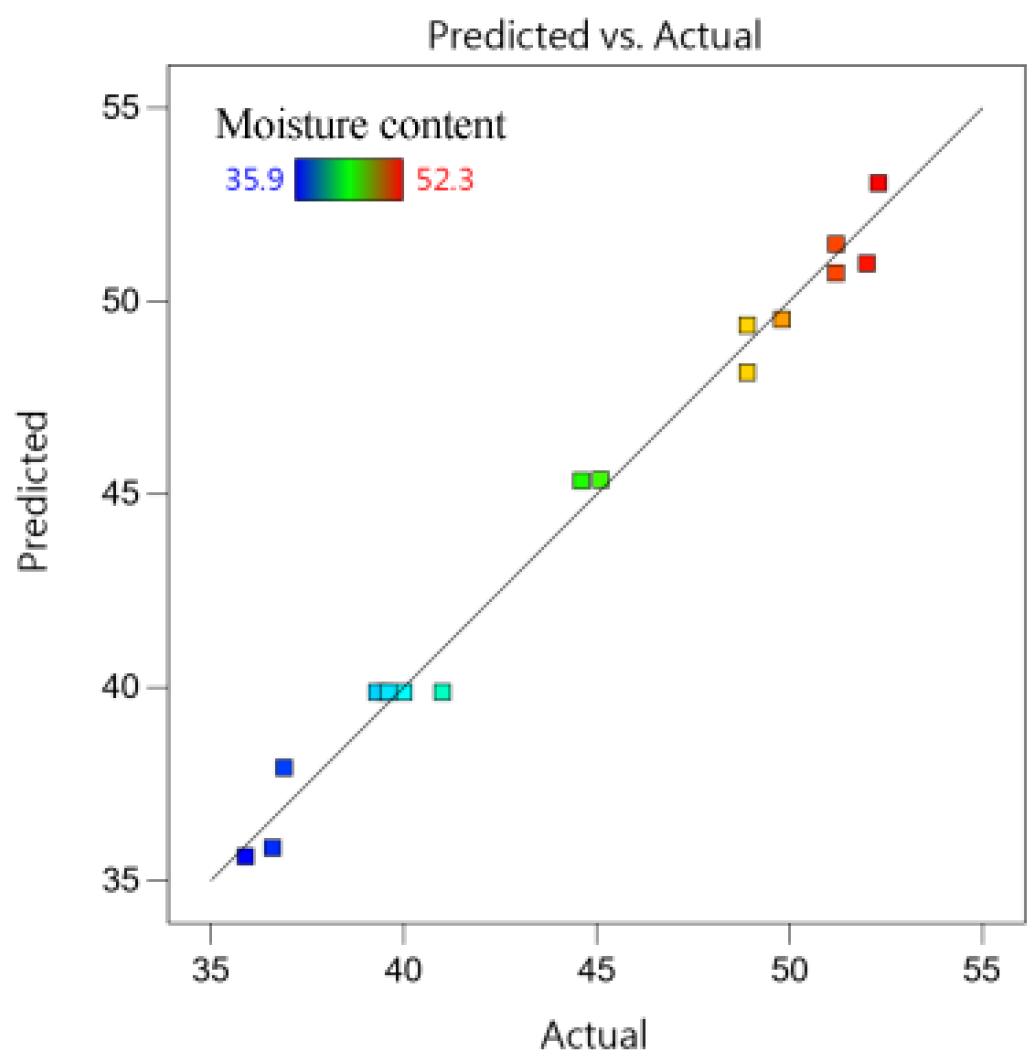
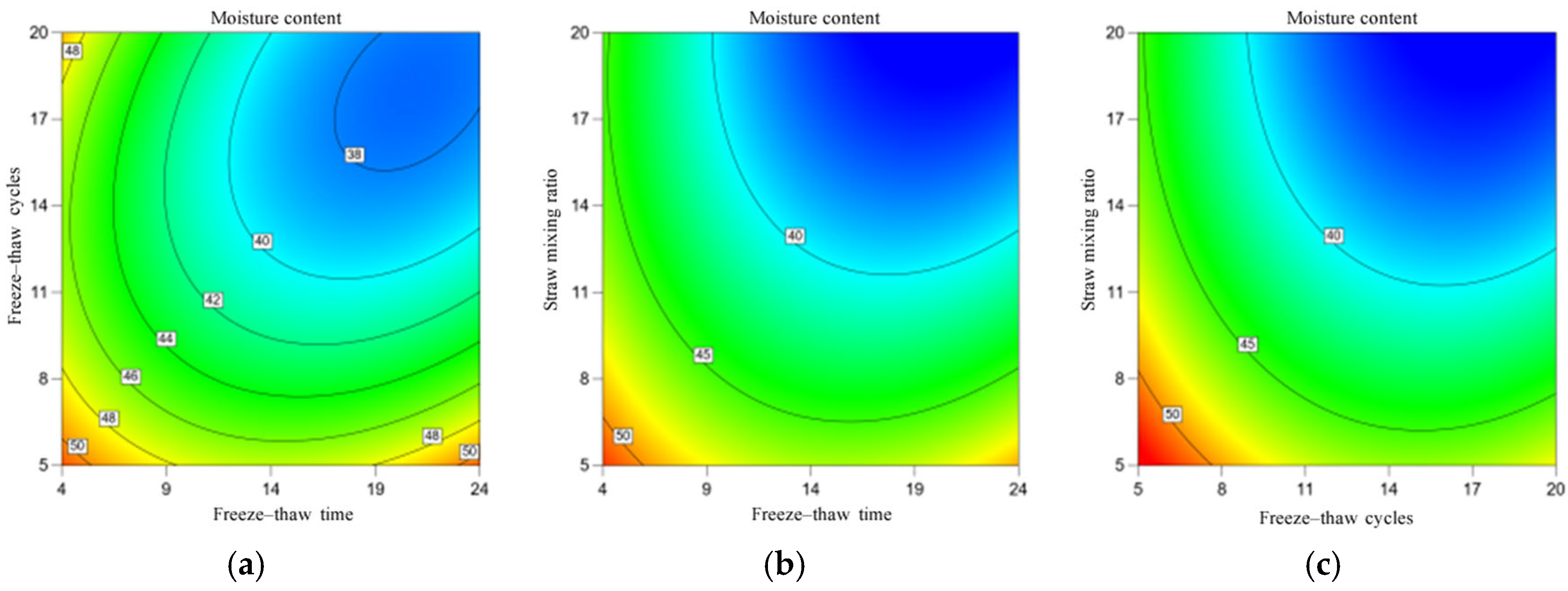

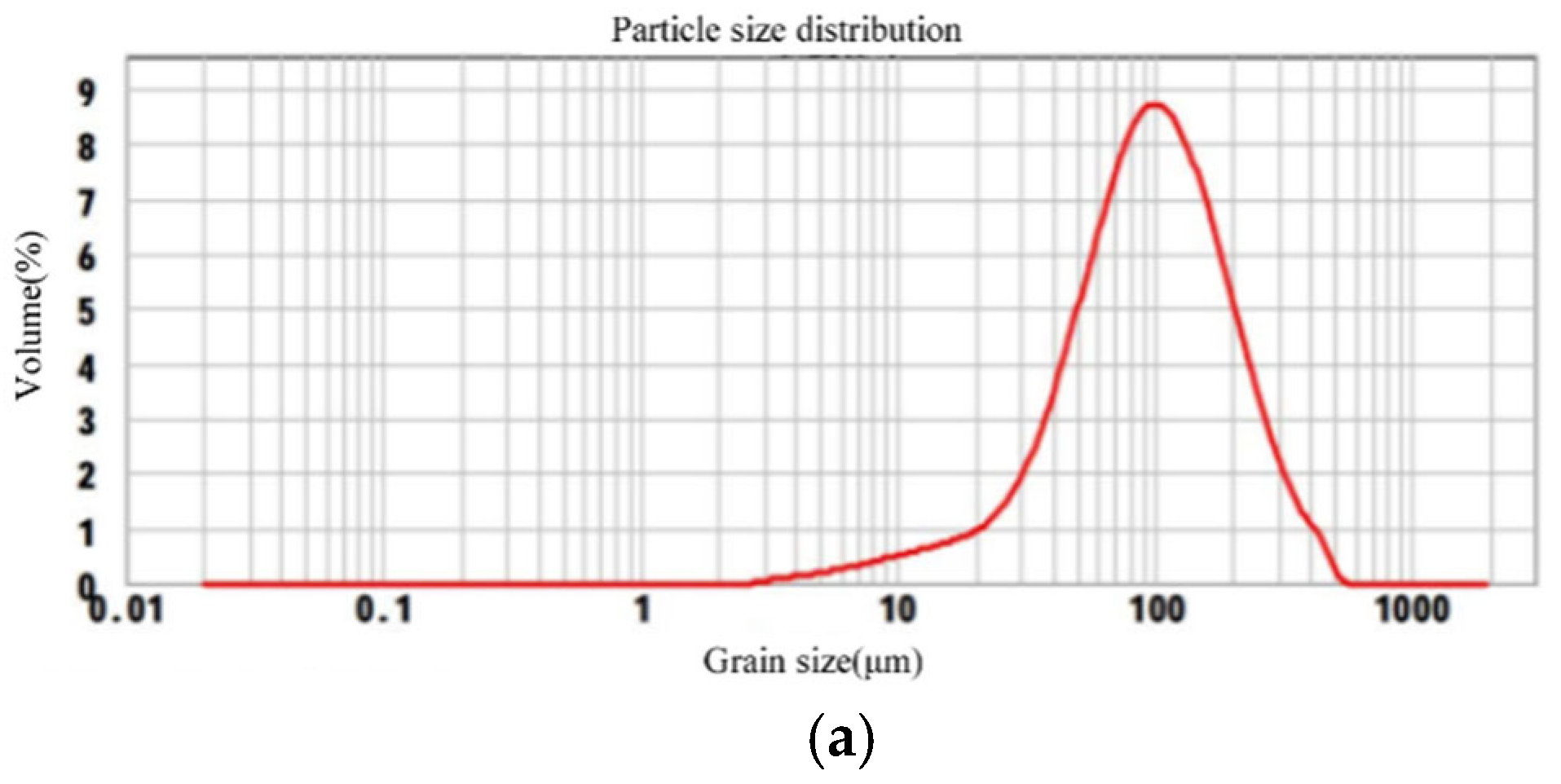

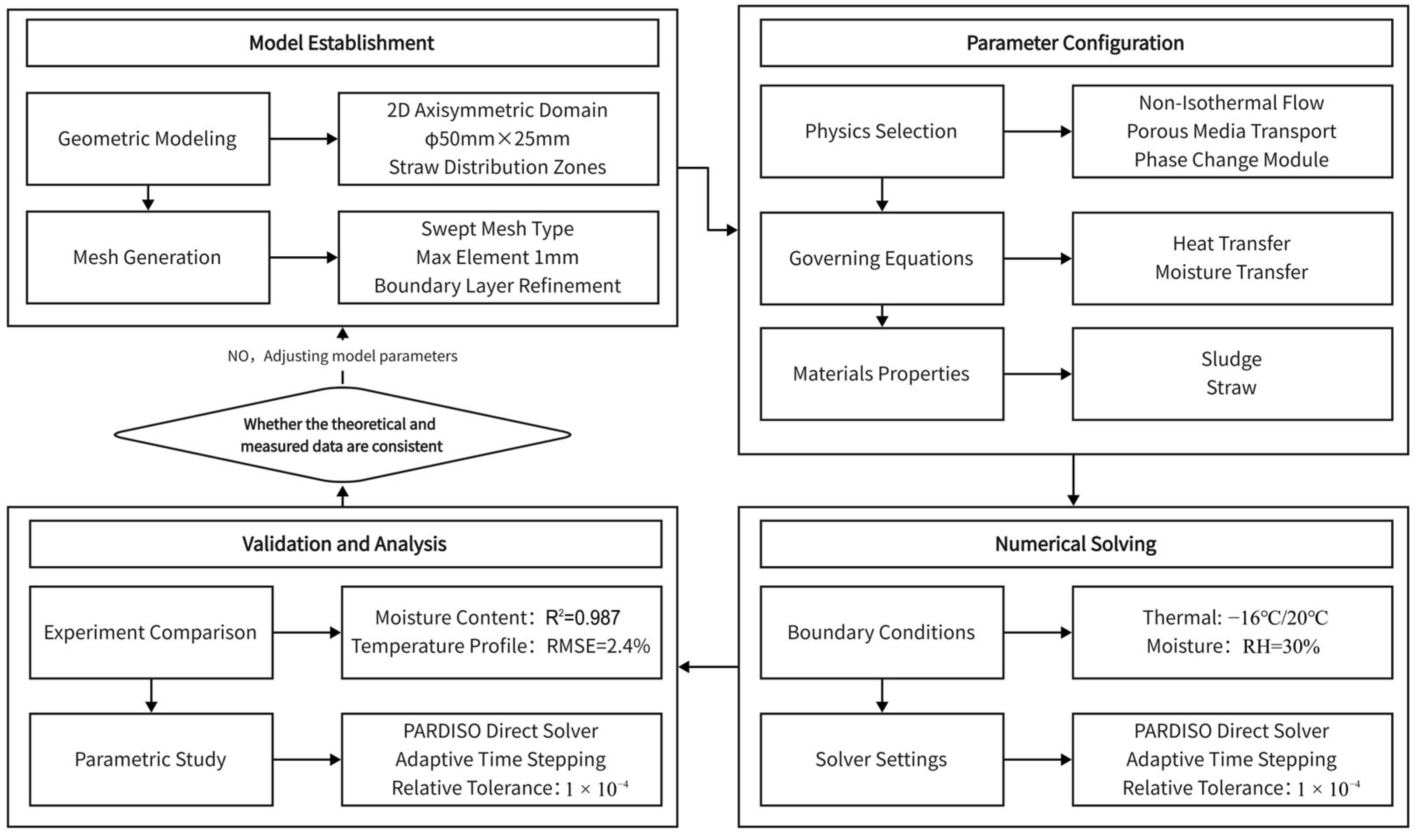

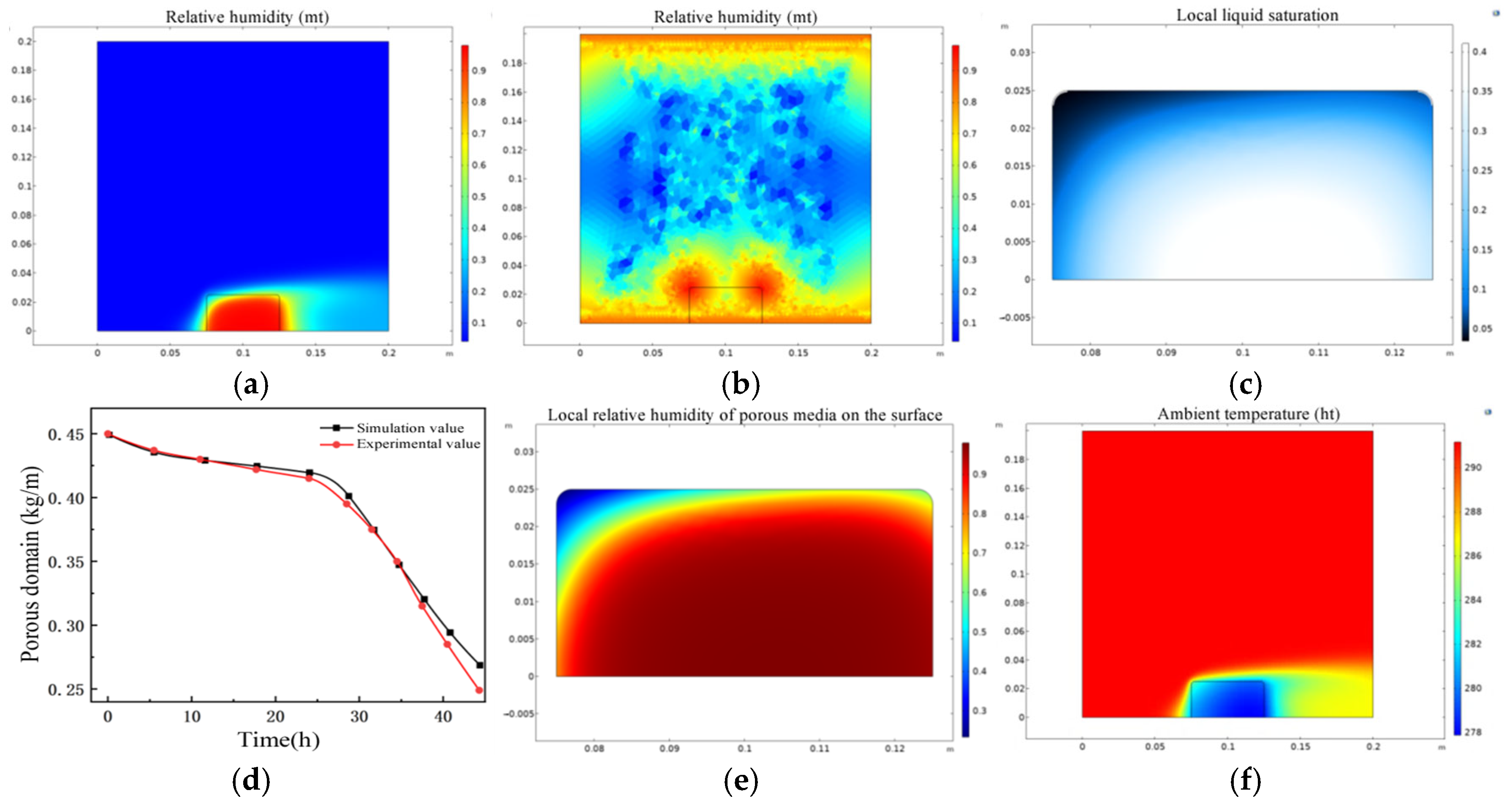

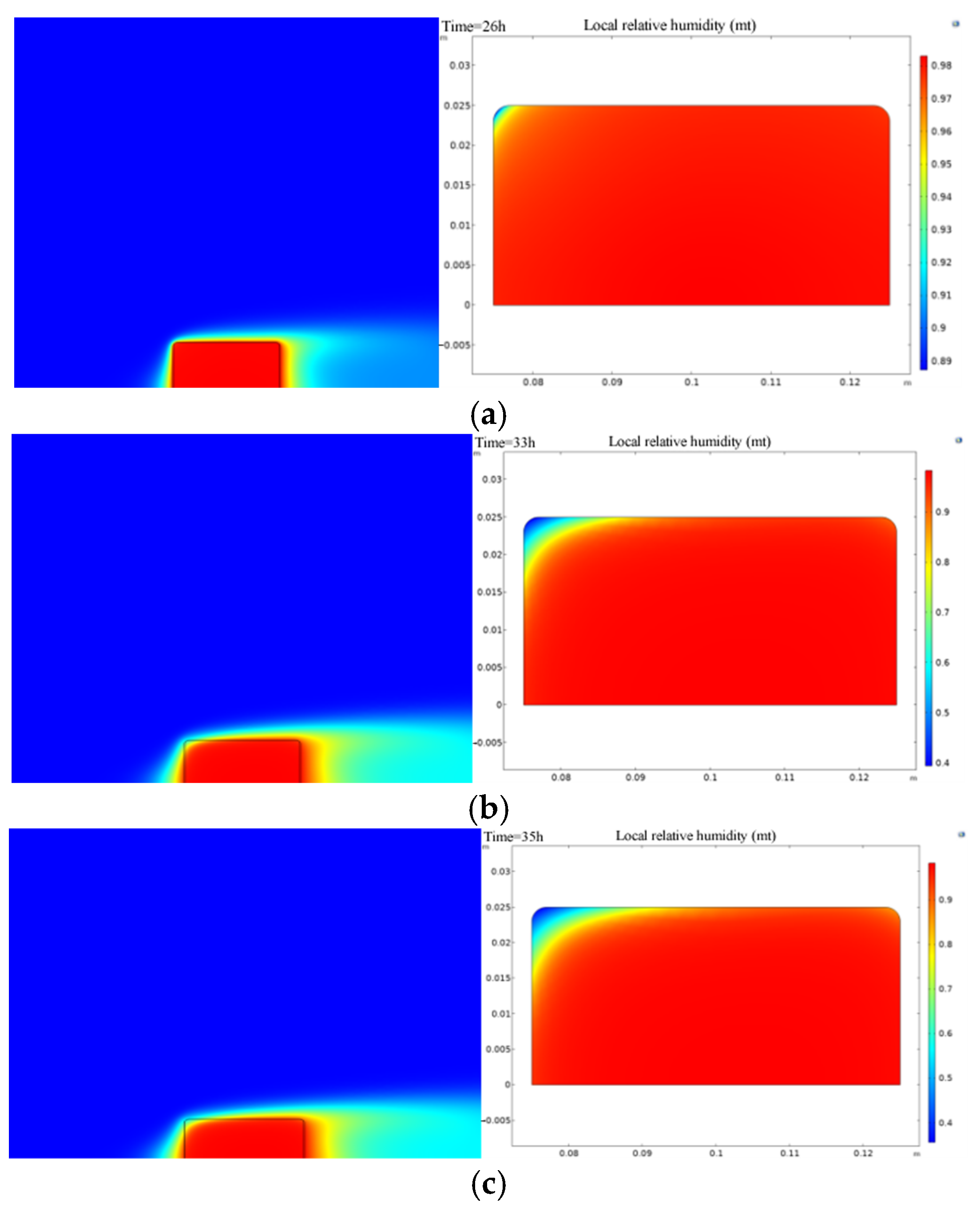
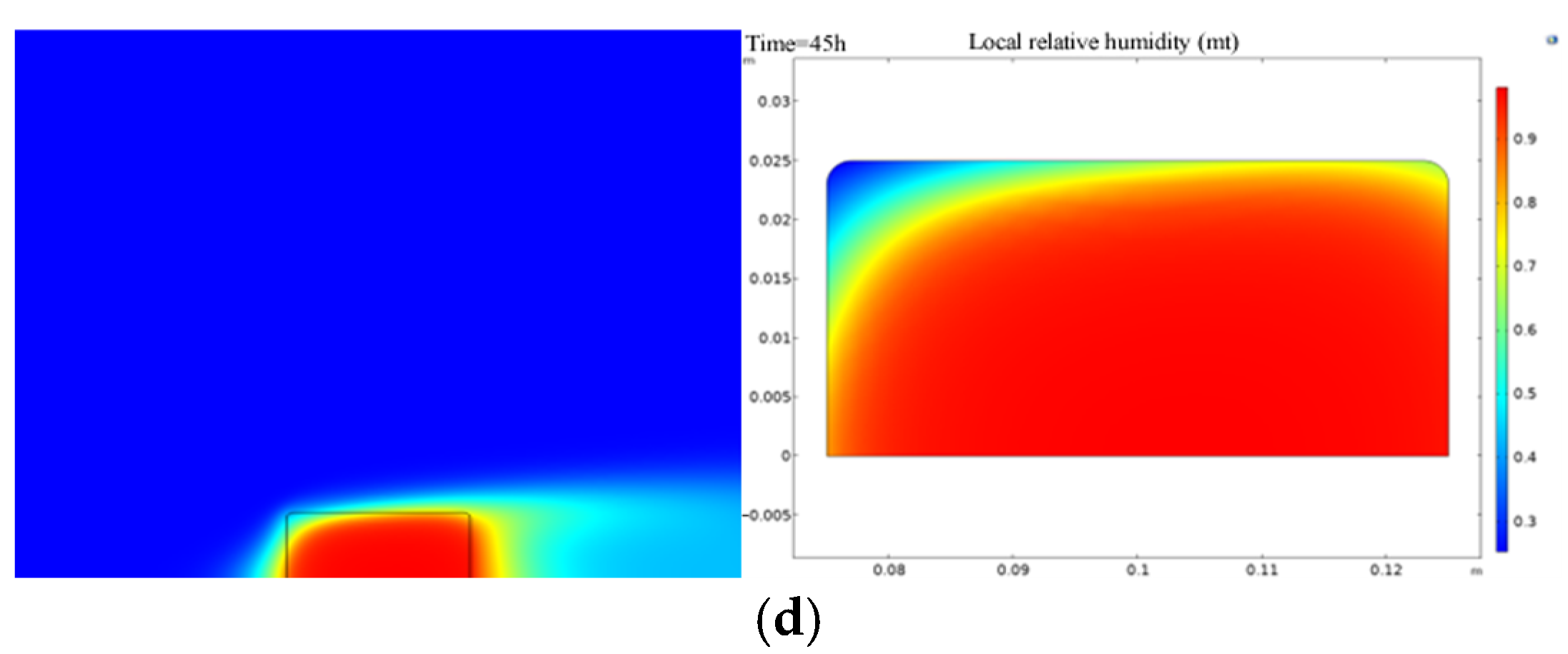
Disclaimer/Publisher’s Note: The statements, opinions and data contained in all publications are solely those of the individual author(s) and contributor(s) and not of MDPI and/or the editor(s). MDPI and/or the editor(s) disclaim responsibility for any injury to people or property resulting from any ideas, methods, instructions or products referred to in the content. |
© 2025 by the authors. Licensee MDPI, Basel, Switzerland. This article is an open access article distributed under the terms and conditions of the Creative Commons Attribution (CC BY) license (https://creativecommons.org/licenses/by/4.0/).
Share and Cite
Guo, Z.; Wang, J.; Wang, Y.; Chi, R.; Gong, X.; Chen, Z. Application of COMSOL Multiphysics Model in Studying Effects of Straw Addition on Dewatering Performance of Residual Sludge During Freeze–Thaw Cycles. Water 2025, 17, 1727. https://doi.org/10.3390/w17121727
Guo Z, Wang J, Wang Y, Chi R, Gong X, Chen Z. Application of COMSOL Multiphysics Model in Studying Effects of Straw Addition on Dewatering Performance of Residual Sludge During Freeze–Thaw Cycles. Water. 2025; 17(12):1727. https://doi.org/10.3390/w17121727
Chicago/Turabian StyleGuo, Zirui, Jiawei Wang, Yao Wang, Riguang Chi, Xujin Gong, and Zhiqiang Chen. 2025. "Application of COMSOL Multiphysics Model in Studying Effects of Straw Addition on Dewatering Performance of Residual Sludge During Freeze–Thaw Cycles" Water 17, no. 12: 1727. https://doi.org/10.3390/w17121727
APA StyleGuo, Z., Wang, J., Wang, Y., Chi, R., Gong, X., & Chen, Z. (2025). Application of COMSOL Multiphysics Model in Studying Effects of Straw Addition on Dewatering Performance of Residual Sludge During Freeze–Thaw Cycles. Water, 17(12), 1727. https://doi.org/10.3390/w17121727





